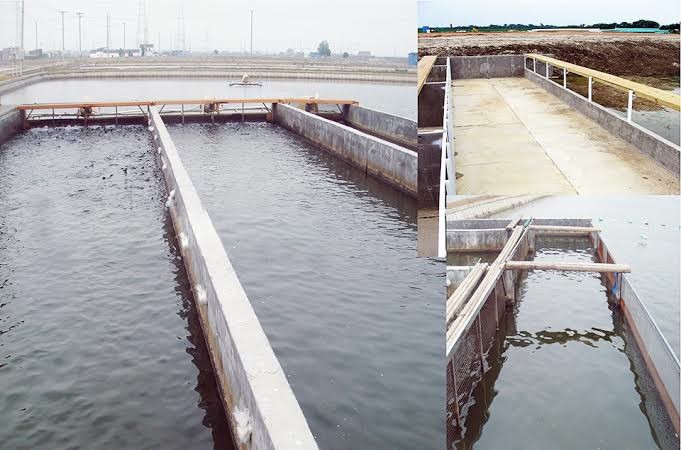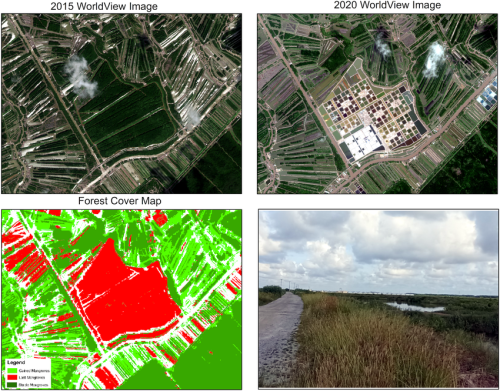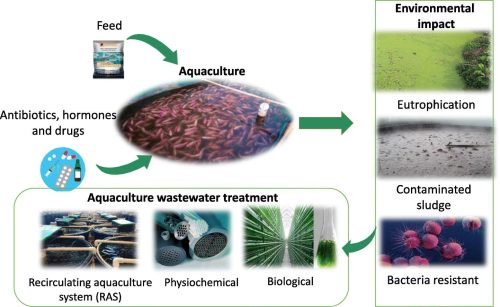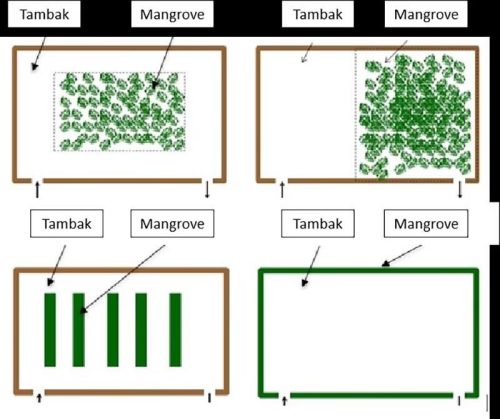Intensive Aquaculture Ponds and Their Environmental Impacts

An intensive pond aquaculture demonstration site, raceways are positioned within the pond for fed fish (left), waste collects in the quiescent zone at the end of the raceways (right) (Photo Credit : Global Seafood Alliance)
Intensive aquaculture, commonly referred to as intensive shrimp or fish farming, has become a significant industry in coastal regions. While it has played an important role in boosting food production and providing economic opportunities, this method of cultivation comes with notable environmental consequences, particularly in the destruction of mangrove forests.
The Conversion of Mangroves for Intensive Aquaculture
One of the primary environmental concerns associated with intensive aquaculture is the large-scale conversion of mangrove forests into aquaculture ponds. Mangroves are highly productive coastal ecosystems that serve as critical habitats for a variety of marine species, including fish, crustaceans, and birds. They also play a vital role in coastal protection by acting as natural buffers against storms, floods, and erosion, and they contribute significantly to carbon sequestration, helping to mitigate climate change.

Mangrove conversion to road and intensive aquaculture (Photo Credit : Pham, T.H., dkk, 2022)
However, the expansion of intensive aquaculture requires vast areas of flat, water-logged land, which often leads to the clearing of mangrove forests. In many cases, entire mangrove areas are removed to make space for shrimp or fish ponds. This deforestation not only destroys biodiversity but also undermines the protective and carbon-storing functions that mangroves provide. Without mangroves, coastal areas become more vulnerable to the impacts of rising sea levels and extreme weather events.
Current State of Coastal Mangrove Forests
Globally, mangrove forests are in decline. According to recent studies, nearly half of the world's mangroves have been lost due to human activities, including aquaculture, urban development, and agriculture (Bhowmik AK, 2022). In Southeast Asia, where aquaculture is a key industry, the situation is particularly alarming (Primavera, J.H, 2020). Coastal areas that were once rich with mangrove ecosystems are now dominated by aquaculture ponds, often abandoned after several years due to environmental degradation and poor water quality.
In Indonesia, which is home to the largest mangrove forests in the world, the situation is no different. The country has lost significant portions of its mangrove cover, largely due to the expansion of intensive aquaculture. This deforestation has led to loss of biodiversity, increased coastal erosion, and reduced carbon sequestration capacity.
Environmental Impacts of Intensive Aquaculture

Environmental impacts of intensive aquaculture (Photo Credit : Ahmad, A.L., dkk, 2022)
The environmental impacts of intensive aquaculture extend beyond the destruction of mangroves. Intensive farming methods typically involve the use of high-density ponds, where fish or shrimp are raised in large quantities. This creates a range of environmental challenges:
- Water Pollution: The high concentration of animals in intensive ponds generates large amounts of waste, which can pollute surrounding water bodies. Excess nutrients from feed and fecal matter contribute to eutrophication, which depletes oxygen levels in the water and can lead to dead zones where no marine life can survive.
- Chemical Use: To manage diseases and pests in intensive aquaculture systems, farmers often use antibiotics, pesticides, and other chemicals. These substances can leach into the surrounding environment, contaminating water sources and harming aquatic ecosystems.
- Habitat Loss and Fragmentation: As mangroves are cleared to make way for ponds, critical habitats for fish, birds, and other species are lost. This results in reduced biodiversity and disruption of ecological balance.
- Soil and Water Salinization: Intensive aquaculture, especially shrimp farming, often leads to increased salinity in soil and water. This can degrade agricultural land in surrounding areas and make it unsuitable for crop production.
Moving Toward Sustainable Solutions
To address these environmental challenges, there is a growing interest in sustainable aquaculture practices, such as silvofishery. This approach integrates mangrove conservation with aquaculture, allowing for a more balanced use of coastal resources. Silvofishery systems maintain a portion of the mangroves within or around the aquaculture ponds, preserving their ecological functions while still supporting fish or shrimp farming.

Silvofishery pattern implementation (Photo Credit : Saraswati A, S., dkk, 2016)
In addition, stricter regulations and better management practices are needed to ensure that aquaculture development does not come at the expense of critical coastal ecosystems. Reforestation of mangroves, alongside sustainable farming techniques, can help restore degraded coastal areas and ensure that the benefits of aquaculture can be enjoyed without compromising the environment.
Conclusion
While intensive aquaculture has provided economic benefits and increased food production, its environmental costs—particularly the destruction of mangrove forests—cannot be ignored. The loss of mangroves has far-reaching consequences for biodiversity, coastal protection, and carbon storage. To mitigate these impacts, it is essential to adopt more sustainable aquaculture practices that harmonize food production with environmental conservation, ensuring that future generations can benefit from both healthy ecosystems and thriving aquaculture industries.

